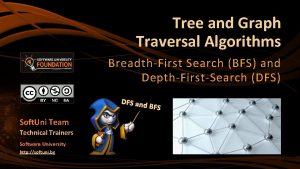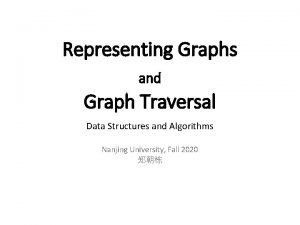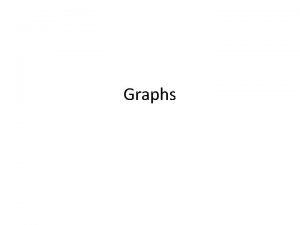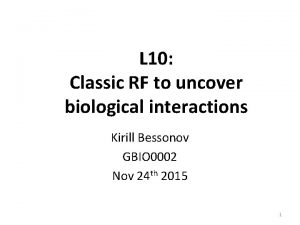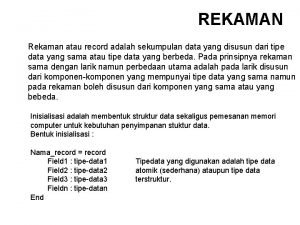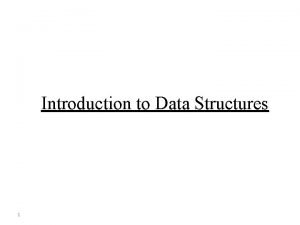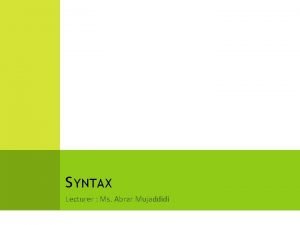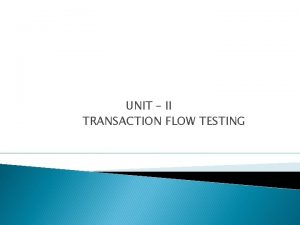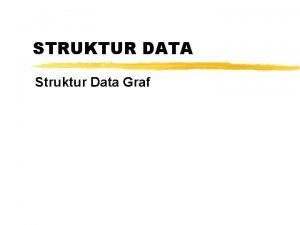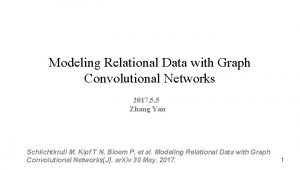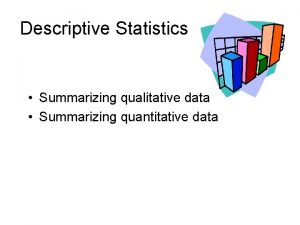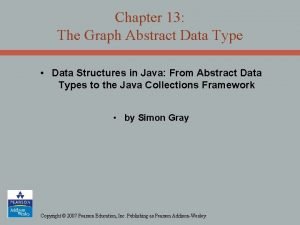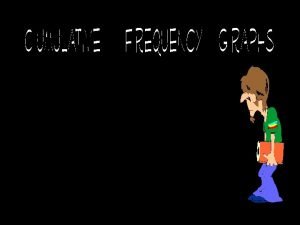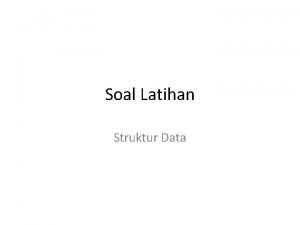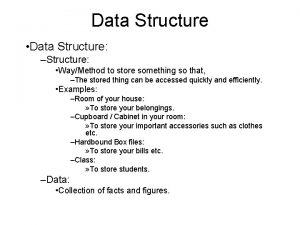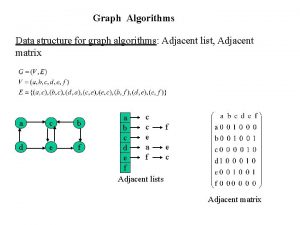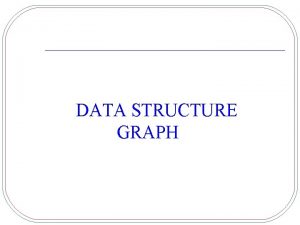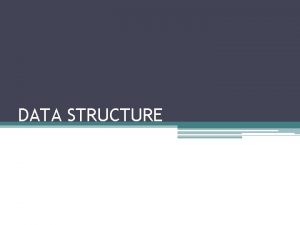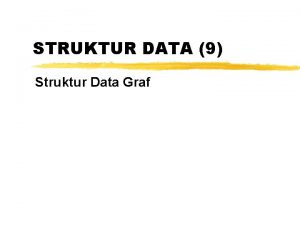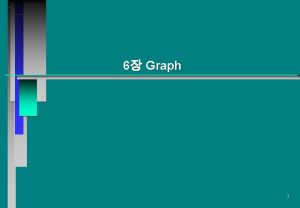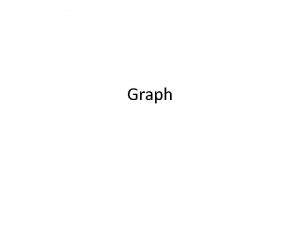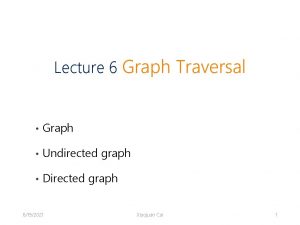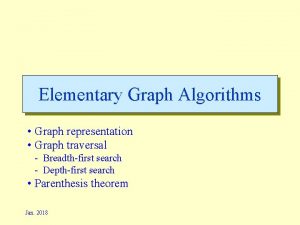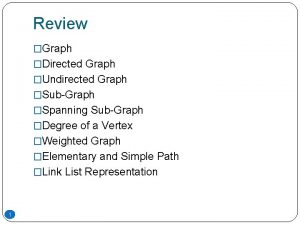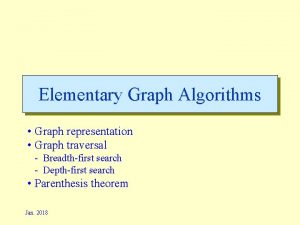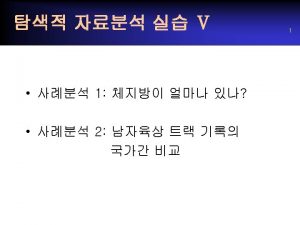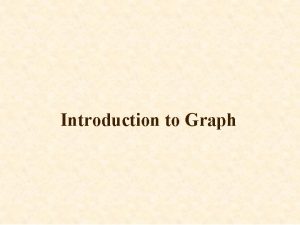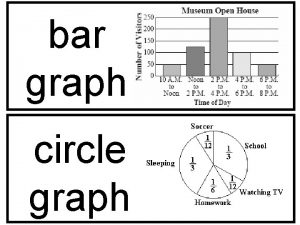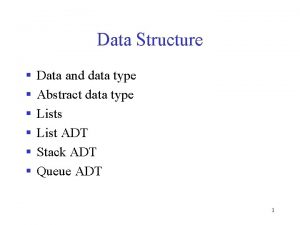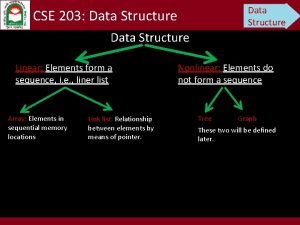Graph Data Structure Graph A graph is a


























- Slides: 26

Graph Data Structure

Graph • A graph is a pictorial representation of a set of objects where some pairs of objects are connected by links. • The interconnected objects are represented by points termed as vertices, and the links that connect the vertices are called edges. • Formally, a graph is a pair of sets (V, E), where V is the set of vertices and E is the set of edges, connecting the pairs of vertices. In the above graph, V = {a, b, c, d, e} E = {ab, ac, bd, cd, de}

Graph Data Structure • Mathematical graphs can be represented in data-structure. We can represent a graph using an array of vertices and a two dimensional array of edges. • Before we proceed further, let's familiarize with some important terms − • Vertex − Each node of the graph is represented as a vertex. • Edge − Edge represents a path between two vertices or a line between two vertices. • Adjacency − Two node or vertices are adjacent if they are connected to each other through an edge. • Path − Path represents a sequence of edges between two vertices. • Cycle: A path that starts and ends on the same vertex

• Directed Graph: A graph that entail edges with ordered pair of vertices and has direction indicated with an arrow. • Undirected Graph: A graph that entail edges with ordered pair of vertices, however it does not have direction define. • Weighted Graph: A graph in which each edge carries a value. • Complete Graph: A graph in which every vertex is directly connected to every other vertex. • In a complete graph every vertex is adjacent to every other vertex. • If there are N vertices then there will be N(N-1) edges in case of complete directed graph and N(N-1)/2 in case of complete undirected graph.

• Degree • In an undirected graph degree of a vertex V is number of edges connected to vertex V. • In a directed graph out-degree of a vertex V is number of edges leaving vertex V. It’s in-degree is number of edges ending at vertex V. • Subgraph: If graph G=(V, E) Then Graph G'=(V', E') is a subgraph of G if V' ⊆ V and E' ⊆ E • Tree: undirected, connected graph with no cycles • Spanning tree: A spanning tree of G is a connected subgraph of G that is a tree

Graph Representations • Following two are the most commonly used representations of graph. 1. Adjacency Matrix 2. Adjacency List • There are other representations also like, Incidence Matrix and Incidence List.

Adjacency Matrix • Adjacency Matrix is a 2 D array of size V x V where V is the number of vertices in a graph. • Let the 2 D array be adj[][], a slot adj[i][j] = 1 indicates that there is an edge from vertex i to vertex j. • Adjacency matrix for undirected graph is always symmetric. • Adjacency Matrix is also used to represent weighted graphs. • If adj[i][j] = w, then there is an edge from vertex i to vertex j with weight w.

The adjacency matrix for the above example graph is:

Adjacency List: • An array of linked lists is used. • Size of the array is equal to number of vertices. • Let the array be array[]. An entry array[i] represents the linked list of vertices adjacent to the ith vertex. • This representation can also be used to represent a weighted graph. • The weights of edges can be stored in nodes of linked lists. • Following is adjacency list representation of the above graph.

Graph Traversals • There are two possible traversal methods for a graph: 1. Depth-First Traversal 2. Breadth-First Traversal

Depth First Search Traversal • Depth First Search algorithm(DFS) traverses a graph in a depth ward motion and uses a stack to remember to get the next vertex to start a search when a dead end occurs in any iteration. • Algorithm 1. Visit adjacent unvisited vertex. Mark it visited. Display it. Push it in a stack. 2. If no adjacent vertex found, pop up a vertex from stack. (It will pop up all the vertices from the stack which do not have adjacent vertices. ) 3. Repeat step 1 and 2 until stack is empty.

DFS Example 1. Initialize the stack

2. Mark S as visited and put it onto the stack. • Explore any unvisited adjacent node from S. • We have three nodes and we can pick any of them. • For this example, we shall take the node in alphabetical order. Output - S

3. Mark A as visited and put it onto the stack. • Explore any unvisited adjacent node from A. • Both S and D are adjacent to A but we are concerned for unvisited nodes only. Output – S-A

4. Visit D and mark it visited and put onto the stack. • Here we have B and C nodes which are adjacent to D and both are unvisited. • But we shall again choose in alphabetical order. Output – S-A-D

5. We choose B, mark it visited and put onto stack. • Here B does not have any unvisited adjacent node. So we pop B from the stack. Output – S-A-D-B

6. We check stack top for return to previous node and check if it has any unvisited nodes. • Here, we find D to be on the top of stack. Output – S-A-D-B

7. Only unvisited adjacent node is from D is C now. So we visit C, mark it visited and put it onto the stack. Output – S-A-D-B-C 8. As C does not have any unvisited adjacent node so we keep popping the stack until we find a node which has unvisited adjacent node. • In this case, there's none and we keep popping until stack is empty.

Breadth First Search Traversal • Breadth First Search algorithm(BFS) traverses a graph in a breadthwards motion and uses a queue to remember to get the next vertex to start a search when a dead end occurs in any iteration. • Algorithm 1. Visit adjacent unvisited vertex. Mark it visited. Display it. Insert it in a queue. 2. If no adjacent vertex found, remove the first vertex from queue. 3. Repeat step 1 and 2 until queue is empty.

BFS Example 1. Initialize the queue.

2. We start from visiting S (starting node), and mark it visited. Output – S

3. We then see unvisited adjacent node from S. In this example, we have three nodes but alphabetically we choose A mark it visited and enqueue it. Output – S - A

4. Next unvisited adjacent node from S is B. We mark it visited and enqueue it. Output – S – A – B

5. Next unvisited adjacent node from S is C. We mark it visited and enqueue it. Output – S – A – B – C

6. Now S is left with no unvisited adjacent nodes. So we dequeue and find A.

7. From A we have D as unvisited adjacent node. We mark it visited and enqueue it. Output – S – A – B – C – D 8. At this stage we are left with no unmarked (unvisited) nodes. But as per algorithm we keep on dequeuing in order to get all unvisited nodes. • When the queue gets emptied the program is over.
 Static data structures
Static data structures Bfs tree traversal
Bfs tree traversal Graph traversal in data structure
Graph traversal in data structure Data structure runtimes
Data structure runtimes Graph data structure python
Graph data structure python Yang merupakan pengertian dari rekaman data adalah
Yang merupakan pengertian dari rekaman data adalah Elementary data organization
Elementary data organization Bridge graph
Bridge graph Wait-for graph
Wait-for graph Webgraph integrated
Webgraph integrated Bow tie structure web graph
Bow tie structure web graph What is a covalent bond simple definition
What is a covalent bond simple definition N++++
N++++ Giant molecular structure vs simple molecular structure
Giant molecular structure vs simple molecular structure Lexical ambiguity examples
Lexical ambiguity examples Deep structure in linguistics
Deep structure in linguistics S s' 's grammar
S s' 's grammar Zinc oxide + nitric acid → zinc nitrate + water
Zinc oxide + nitric acid → zinc nitrate + water Surface structure
Surface structure Data flow anomaly state graph
Data flow anomaly state graph Data flow testing
Data flow testing Apa itu vertex
Apa itu vertex Modeling relational data with graph convolutional networks
Modeling relational data with graph convolutional networks How to summarise qualitative data
How to summarise qualitative data Graph abstract
Graph abstract Tmadas
Tmadas Maksimum jumlah busur dari n simpul dalam directed graph
Maksimum jumlah busur dari n simpul dalam directed graph

